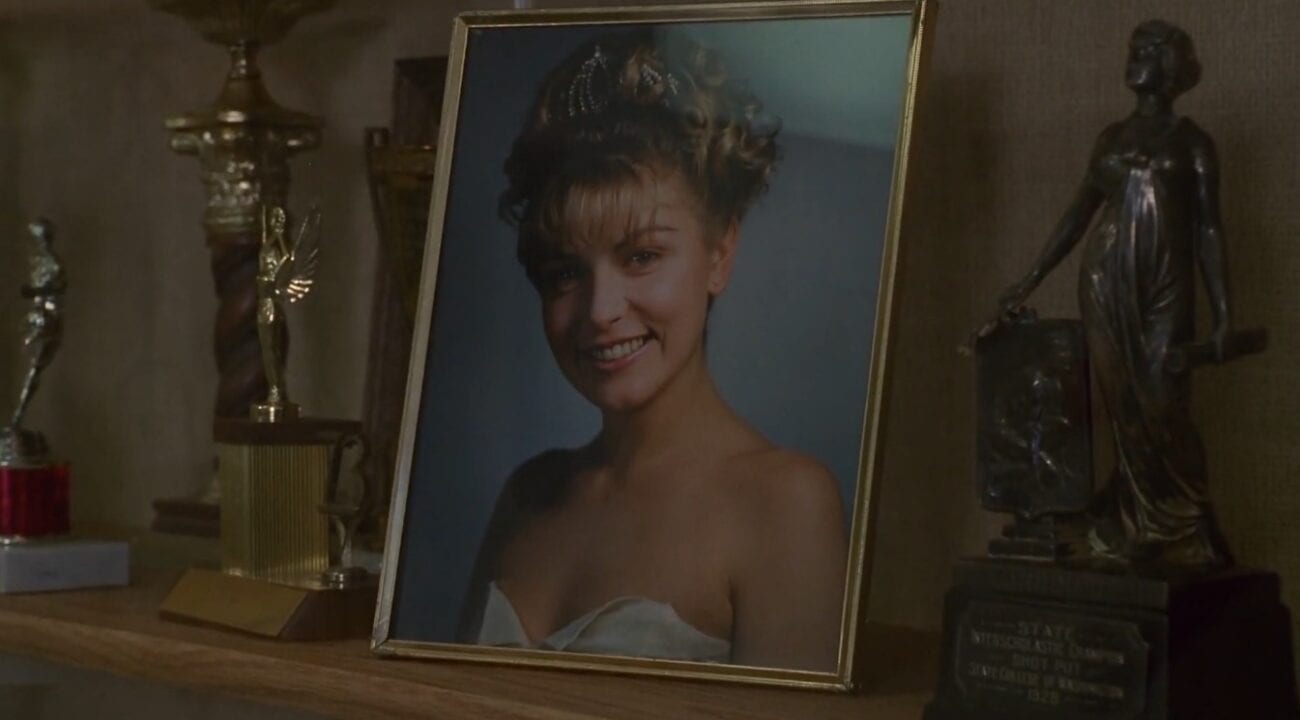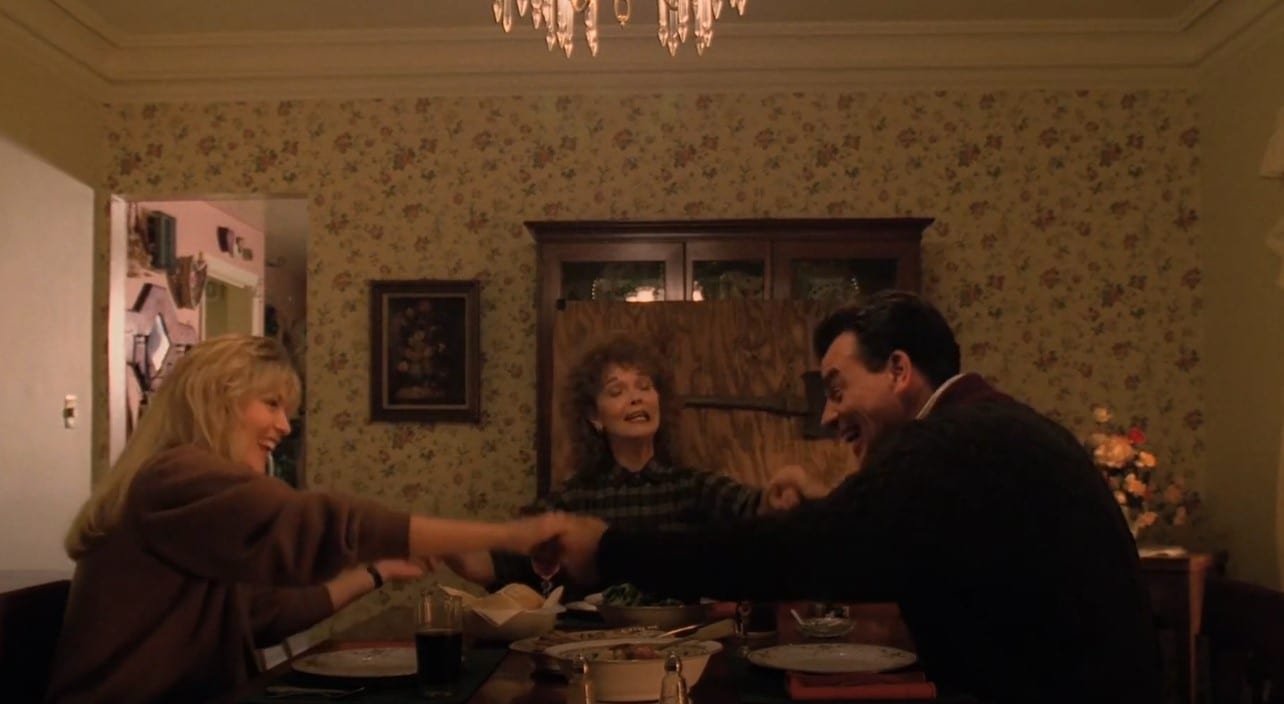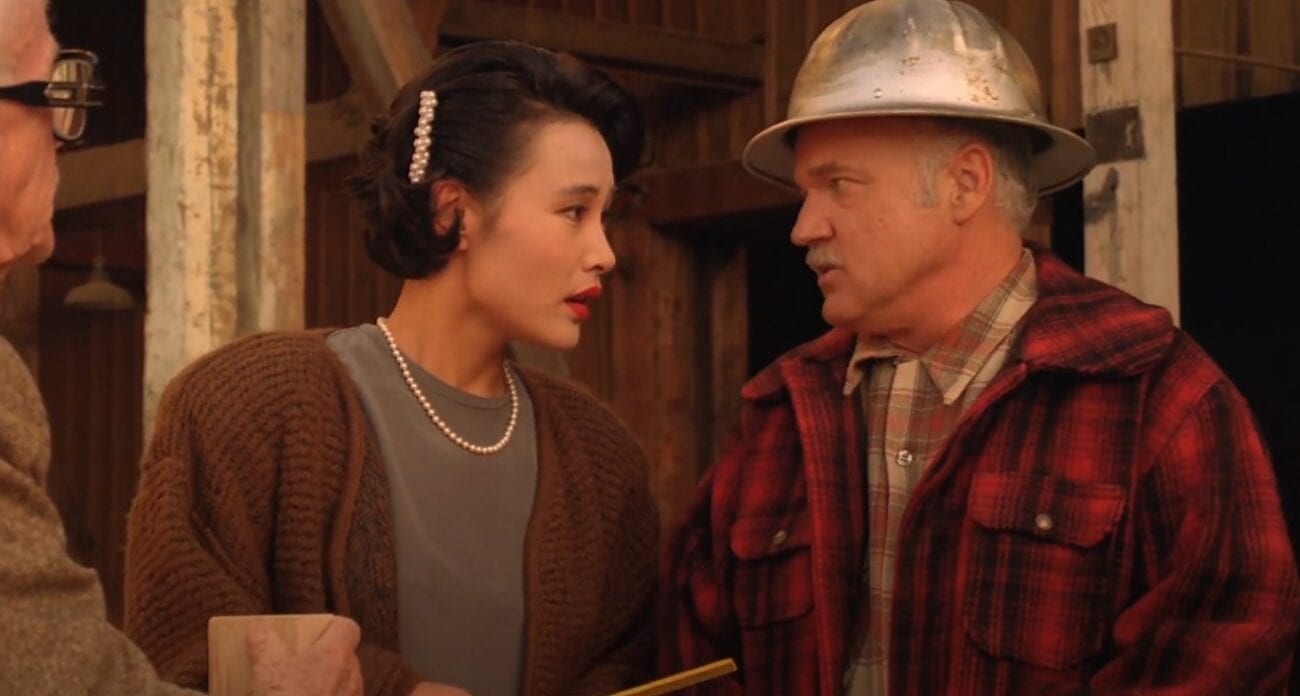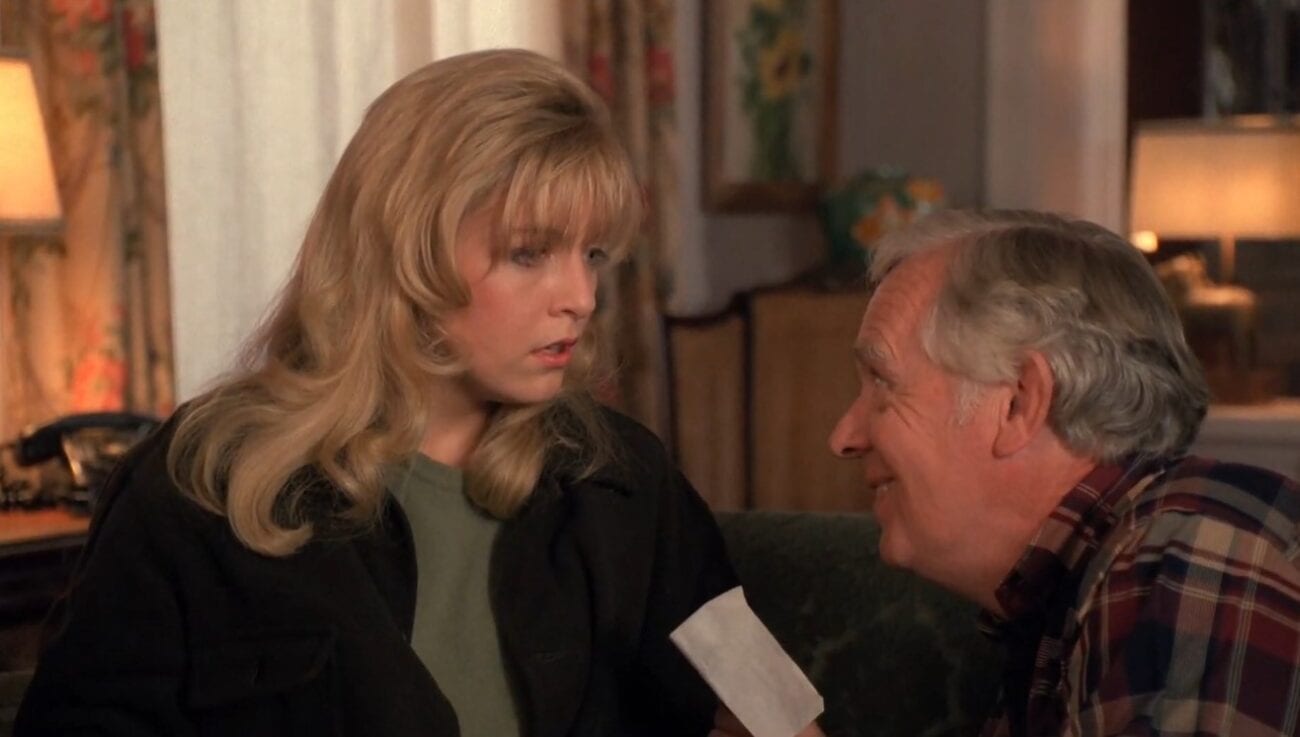In 2014, just shy of 25 years after the pilot of Twin Peaks first aired, David Lynch released unseen Twin Peaks footage for the first time since the prequel film Fire Walk With Me. For any other series or franchise, a compilation of deleted scenes wouldn’t seem like such a big deal, but this is Twin Peaks, and The Missing Pieces feels closer to a prologue to The Return than mere bonus material. It incorporated a new sound design and was put together with as much care as any of Lynch’s features.
What you are about to see are missing pieces.
The shooting script of Fire Walk With Me is significantly different from the final film but also edited down from the original screenplay co-written by Lynch and Twin Peaks veteran Robert Engels, which would have an approximate runtime of nearly five hours. The 90 minutes of footage chosen for inclusion here provide clues to the bigger mystery of Twin Peaks and build on themes that carry into The Return. But even the title is a play on its very existence within Twin Peaks’ cosmology. Did these scenes take place within the official canon? Or are they glimpses of an alternate timeline? Are the missing pieces the scenes themselves, or the fact that there is something actually missing in nearly every one of these scenes, like an unplanned thread of consistency, discovered decades later in the editing process, that brings everything together?

“You have your own MO, don’t you, Agent Desmond.”
After a brief title zoom on Laura’s homecoming photo and a transition through the Red Room, The Missing Pieces begins with agents Chester Desmond and Sam Stanley leaving the tiny Deer Meadow morgue and interacting with the strange characters at Hap’s. The narrative has skipped over Gordon Cole’s cryptic instructions with Lil, his “mother’s sister’s girl,” that Desmond breaks down for Stanley afterward.
Instead, after leaving Hap’s, where Jack warns them not to proceed with their investigation, Desmond tells Stanley, “I think you and I ought to see the sunrise at Fat Trout Trailer Park.” When Sam asks if this is some kind of code, Desmond replies “No, I’m speaking plainly. I mean exactly what I said.”
Just as in Fire Walk With Me, when Desmond breaks down Gordon Cole’s code, he emphasizes what isn’t said. In The Missing Pieces, there is no code to break down. The scene is almost poking fun at the audience’s proclivity to weave every detail into elaborate theories, but that’s not going to stop me. It could also just underscore that the following scenes should be taken as exactly what they are, missing pieces. Whether their absence is significant or not is dependent on each scene and how it evokes the emotions and thoughts Lynch intended.
In The Missing Pieces, we are treated to a lengthy brawl between Desmond and Sheriff Cable. Desmond easily overpowers the small-town brute and finishes his knockout with, “This one’s comin’ from J. Edgar,” referring back to Cable’s mockery of the FBI. A popular and compelling theory from John Thorne at Blue Rose Magazine about the first act of Fire Walk With Me claims that the Deer Meadow sequence is actually Agent Dale Cooper’s dream, his subconscious reexamining of the Teresa Banks murder case, and that Chet Desmond is a projection of Cooper’s dream self. This scene only enhances that theory, implying that Cooper has violent revenge fantasies brewing over past failures.
The Missing Pieces then transitions to the Philadelphia FBI headquarters, where we get a quick glimpse of Cooper energetically talking to Diane, offscreen and unheard, as she is in the entirety of Twin Peaks thus far. There is also an interesting scene between Stanley and Cooper in a room full of old appliances and a weird chemical bath.
With the “dream theory” in mind, there are a lot of curious connections between the room above the convenience store we see later and the back room of Hap’s, down to the flickering lamp, the woodsman on the floor, and the green Formica chair. It’s either the Black Lodge bleeding into Cooper’s dream/Desmond’s reality, or it was actually part of Cooper’s investigation into Teresa Banks’ murder, and the offputting atmosphere found its way deep into his subconscious and became part of his dream world. Regardless, Jack’s lines about Hap, “He’s good and dead,” and “He didn’t suffer,” are Lynchian dark-comedy gold.

“We’re Not Gonna Talk About Judy”
I distinctly remember reading about the extended Jeffries scene, right down to the burnt black wall mentioned in the script. I assumed it was never filmed, so I was pretty surprised to see the scene play out pretty much exactly as the shooting script described. Naturally, David Bowie’s entire presence brings an ethereal sense of magic; it’s impossible to imagine this scene working with anyone else.
The Jeffries sequence ends with the bellhop screaming, “Are you the man?” and the following scene is called “Mike is the man.” Another weird Mike/Philip connection, but it’s used here by Lynch to pair the two scenes and bring the FBI story into that of Twin Peaks and Laura Palmer. It’s an effective transition, especially with the music cue, and it plays out much better than the montage-like sequence we see in FWWM.
And then there’s the scene with Leland Palmer stomping into the dining room. I love this scene, although the tension between the two women when Leland first arrives tells us they are prepared for the worst. The scene that does make it into the film reveals Leland at his worst. It adds a layer to the tragedy of the Palmer family to see them like this, a happy, loving family engaging in a cathartic ritual of laughter. But then again, these are missing pieces. Maybe Lynch’s intentions in putting this scene in The Missing Pieces suggests that more of these moments might have made a difference in Laura’s fate. I don’t actually think it’s so cynical, or preachy—this scene is good because it reveals the complexity of Laura’s life and family. The Palmers, despite everything, are capable of love and laughter.

“None of this would have happened if you’d said ‘untrimmed.’”
As Joel from Lost in the Movies points out in an interview with John Thorne, The Missing Pieces showcases a shift in style for Lynch that began with his disappointment at the reaction to Fire Walk With Me, one rippling through his next few films and becoming fully realized in The Return. The aforementioned fight between Desmond and Cable is a good example, using long takes to build tension and letting an unusually long amount of screen time pass with no dialogue. There also seems to be exactly the amount of space he tends to want to give a scene, even if it is meaningless on the surface.
It’s also surprising how many characters were filmed and cut, and hard to imagine that we had to go so long without seeing some of these scenes. Fire Walk With Me often felt disconnected from the show and the rest of the townspeople, since nearly everyone outside of Laura’s closest circle was cut. It feels like an entirely different cast, especially with Moira Kelly replacing Lara Flynn Boyle as Donna. Since the film is a prequel, there wasn’t much of a need to take these characters somewhere unfamiliar. Instead, they explore the characters where they were just as we are first introduced into their lives a week later in the world of the original series.
We see Ed and Nadine stop by the Double R, but Nadine storms off when she sees Norma. Unlike the cheery atmosphere normally accompanying the diner, the place is quiet, and the German waitress Heidi is sitting in a booth with a nosebleed, her head tilted back with a tissue pressed against her face yet still managing a polite giggle. Shelly takes over Laura’s Meals on Wheels route, and Norma starts to sob before Ed returns to comfort her. It’s in many ways an inversion, a negative image of the scenes and traits we associate with the Double R and yet perfectly consistent. I don’t know how else to describe it, but it makes this fictional place feel so much more alive and real.
At the Packard Sawmill, Pete Martell is teaching Josie Packard some of the mundane details of the lumber business as an irate Mr. Mibbler demands a refund on a block of wood. As Pete explains the differences between trimmed and untrimmed wood, I can’t help but think there was no way this scene wasn’t written with deleted scenes in mind. Any industrial process, even filmmaking, is bound by standards and financial ties that are often incomprehensible to outsiders. As if referring to Fire Walk With Me’s final cut and the reaction, Pete explains to Mr. Mibbler, “None of this would have happened if you’d said ‘untrimmed.’”

“It’s happening again.”
Lynch has been very candid about his dissatisfaction in giving a definitive answer to the mystery of who killed Laura Palmer. Even the revelation in Season 2 that Leland killed Laura under the influence of demonic possession left an open-ended question as to the nature of BOB. Instead of exploring that further, Fire Walk With Me chose to focus on Leland’s abusive nature and blur the distinction between his own will and BOB’s, making the question even more difficult to answer for certain.
In The Return, Sarah Palmer’s connection to Judy and her role in Laura’s abuse is also examined. There are more scenes between Laura and Sarah in The Missing Pieces that suggest this idea was percolating from the beginning. First, there’s the cigarette, which she passes to Laura while her hands are full of groceries (entirely dairy products, which I’m sure itself is no coincidence), then immediately scolds her daughter for walking away with it. “You’ll never be a smoker if you don’t start.”
My first impression of the blue/red sweater mixup prior to The Return was that it hinted at possible multiple timelines in which Sarah was somehow stuck. The Return certainly expands on Sarah’s trauma as expressed through time loops and random mixups. All that said, I don’t think there’s anything supernatural happening with her sweaters now, other than revealing that she’s losing herself to dark forces again. At the very least, her appearances in The Missing Pieces confirm that there was something more mystical about Sarah during the making of Fire Walk With Me that wasn’t explored but became a powerful presence in The Return.
There is still a distinct difference in how Laura feels at the Hayward home, a refuge among her chosen family. Doc Hayward’s character has always worked as an effective foil of a good father to Leland’s bad one. Leland is actually possessed by a spiritual entity, whereas Doc Hayward enters attempting to perform a magic trick with the phrase “ipso facto” and can’t seem to pull it off. But he still manages to deliver a message to Laura that comforts her, making him truly magical.

“I have the fury of my own momentum.”
The Missing Pieces’ final act is probably its most anticipated since it ostensibly picks up where the Season 2 finale left off. But rather than answering any definitive questions, it’s more like a post-credits epilogue. Annie is brought into the hospital wearing Caroline’s floral dress, her face caked with blood. Shortly after, we see her being tended to by a nurse as she bolts up and delivers the same line she did to Laura about being in the lodge with the good Dale. After fading back to her catatonic state, the nurse slips the ring from Annie’s finger.
The meaning of the ring or how it works in Twin Peaks isn’t often very clear. Sometimes it’s merely a harbinger of doom, and Cooper warns Laura not to take it when offered. But it also appears to offer some kind of protection against BOB, perhaps by “wedding” Laura to MIKE.
After watching The Missing Pieces and noticing what is missing from each scene, it’s jarring how the ring just appears, almost as a distraction. I think ultimately it doesn’t matter what the ring does as much as that its placement in Fire Walk With Me and The Missing Pieces implies that it’s powerful. Maybe it doesn’t have any effect other than as a symbolic totem for the audience. In other words, the owl ring has a tendency to show up in places it shouldn’t, making it the un-missing piece.
Lynch’s creativity stems from his commitment to producing art that stays as close as possible to his intuition. Obviously, transposing any idea onto a canvas, record, or film will require adjustments and lose details, like a copy of a copy. The story of Twin Peaks is as much about the pressure of the entertainment industry to control Lynch and Frost’s story, and the evolution in Lynch’s filmmaking following the experience with Fire Walk With Me is a direct line to the unrestrained, “pure heroin Lynch” we get in The Return. That even a collection of deleted scenes can form a work of art worthy of analysis is a testament to the artistry behind Twin Peaks.

What’s missing?
Here’s a quick rundown of a few “missing pieces” I noticed within The Missing Pieces.
- In the first scene, a place to sleep for Sam Stanley. Desmond’s MO
- A lot is missing from Hap’s, mostly any information on Teresa Banks. Say Hello to Jack
- Diane is missing from the scene where Cooper is talking to her. Cooper and Diane
- Cooper and Stanley discuss Desmond’s disappearance. Stanley’s Apartment
- Of course, any talk about Judy. Buenos Aires/Above the Convenience Store
- Again, Desmond has gone missing, as does Jeffries yet again. Cole shouts out to an empty room, “Am I alone in here?” Buenos Aires/Above the Convenience Store
- Bobby and Mike are missing the money they owe Leo, and their cocaine supply is running low. Mike is the Man
- Sarah Palmer is missing her sweater, and then she is also looking for her keys. School Books
- When Laura returns, she is still missing her school books. The Palmers
- “Where’s my ax?” The Palmers
- Laura goes missing from her bedroom. Laura’s Party
- According to Mr. Mibbler, there’s ⅞” missing from his two-by-four. 2×4
- Sadly, there are no diners at The Double R. Kind of Quiet
- Laura also skips out on Meals on Wheels duty. Kind of Quiet
- Doc Hayward is missing the red rose from his magic trick, and Laura spends most of the scene looking for her cigarettes. I’m the Muffin/ The Ring
- Sarah Palmer thinks she’s missing her blue sweater, but she’s actually missing time. Bob Speaks Through Laura/Blue Sweater
- Major Briggs is missing from the reflection as if the mirror is a haunting glimpse into the future. Bobby and Laura in the Basement
- To Lucy, anytime someone leaves her sight, they’ve gone missing. Goodnight Lucy
- There’s no prowler at the Packard house. Goodnight Lucy
- Sheriff Truman is missing from duty during Laura’s murder. Goodnight Lucy
- The fireplace isn’t burning in the Log Lady’s cabin. Distant Screams
- Bobby’s cocaine is missing, replaced by baby laxative. Baby Laxative
- The ring is missing from the podium. Epilogue




